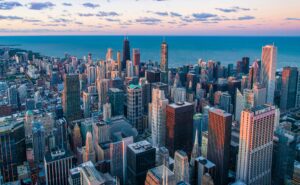Source >>>
Nearly half of city GDP is at risk of disruption from nature loss, according to a new study published by the World Economic Forum.
Cities currently contribute 80% to global GDP and account for 75% of global greenhouse emissions.
Yet, according to the report, 44% of GDP in cities around the world (around $31 trillion) is at risk of distribution from nature loss.
This is because environmental change is compromising cities stability, this is through the form of flooding, drought, urban heat, and poor air quality – all of which will be exacerbated by the climate crisis.
The report calls for multistakeholder action to integrate nature as infrastructure into the built environment.
According to the report, spending $583bn on nature-based solutions for infrastructure and on interventions that release land to nature could create more than 59 million new jobs by 2030, including 21 million livelihood-enhancing jobs that are dedicated to restoring and protecting natural ecosystems.

The report finds that by incentivising investments in natural capital, cities can also unlock the benefits of nature.
Nature-based Solutions are on average 50% more cost-effective than man-made alternatives and deliver 28% more added value.
Akanksha Khatri, Head of Nature and Biodiversity, World Economic Forum said: ‘In the conventional paradigm, urban development and environmental health are like oil and water. This report shows that this does not have to be the case. Nature can be the backbone of urban development. By recognizing cities as living systems, we can support conditions for the health of people, planet, and economy in urban areas.’
Mauricio Rodas, Co-Chair of the Global Commission on BiodiverCities by 2030 and former mayor of Quito, Ecuador added: ‘As cities think about building for the post-pandemic future, they have a priority to provide their citizens with a more equitable and prosperous quality of life by protecting their natural resources. In this report, we offer actionable solutions to heal the relationship between cities and nature. We need all stakeholders to invest in urban nature.”
‘Cities don’t need to be concrete jungles in conflict with nature in and outside their boundaries. They should be places where all people and nature co-exist and thrive together. Nature-based solutions offer wider benefits than traditional engineered ‘grey’ solutions – such as improving resilience, increasing citizens health and wellbeing and moving cities to net zero. Using powerful new digital mapping tools to help us understand cities as complex systems, we are increasingly adopting nature-based solutions in our projects – this needs to be accelerated on a global scale.’
Photo by Pedro Lastra

